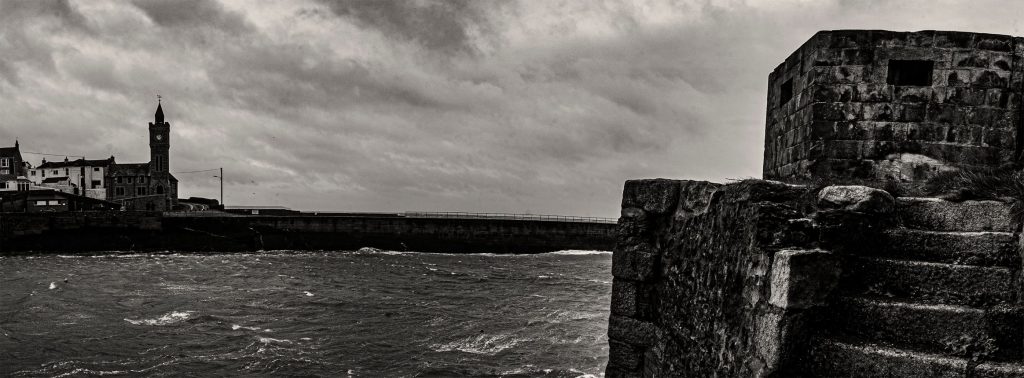In reaction to the threat of invasion by Nazi Germany in the summer of 1940, Britain hastily constructed multiple series of hardened defences that included 89,000 pillboxes; these have been described as 20th century castles.
After the fall of France in June 1940 and with the very real threat of invasion of Britain by Hitler’s all-conquering forces, Winston Churchill’s government responded immediately with determination and ruthless efficiency to turn the coastal areas into a war zone. New defences included trenches, anti-tank barriers and miles of coiled barbed wire as well as pillboxes. Under the direction of General Ironside, these structures were concentrated across the south and east of the country and designed to give strength in depth. Strong points defended key river crossings, road and rail junctions, and natural barriers such as rivers, canals, escarpments and dense woodland were strengthened with the concrete defences and known as stop lines. Spitfire and Hurricane fighter airfields, radar stations, command and control centres and observation posts proliferated, and these were organised geographically into Fighter Command’s 10, 11 and 12 Groups to protect London and the south east from German bombers.
Pillboxes
The Germans were the first to construct concrete pillboxes as we know them today as part of their elaborate trench defence systems in the First World War. The name pillbox emanates from their close appearance to the small round boxes used to hold medication. In 1940 British pillbox design was the responsibility of the Directorate of Fortifications and Works, which specified 9 different designs. Royal Engineers Officers briefed and supervised the local contractors who built them.
The irregular hexagon type 24 was the most common with a Bren gun embrasure and held up to 8 soldiers. The smaller type 22 held 6, while the type 25 was circular and type 26 square. Less common, the larger type 27 was octagonal and included an open well for an anti-aircraft gun and the type 28 housed a 2pdr anti-tank gun. All pillboxes were designed with an internal anti-ricochet wall, commonly Y- shaped and some with sliding steel shutters on the embrasures to protect against poison gas and flamethrowers.
Local modifications also evolved, and many pillboxes were cleverly camouflaged to masquerade as something else such as kiosks, pigsties and summer houses. For protection, embrasures needed to be as small as possible, but this compromised visibility. Due to this and other limitations, by early 1942 the pillbox was deemed redundant, with GHQ Home Forces stating all experience of modern war points to the fact that the pillbox is not a suitable type of fortification for either coastal or nodal points of defence. From then on temporary, earthen field defences with 360 degree action, well-sited and well-concealed became the accepted defence policy.

Ghosts in the Landscape
Each dilapidated bunker and ruinous pillbox, once full of human activity and purpose is now silent and abandoned, their mission complete.
At the end of the 18th century artists of the Romantic Movement including JMW Turner and John Constable, rediscovered the great medieval castles after they had fallen into neglect and dilapidation following the Civil Wars of the 1640s. They promoted them as ideal subjects for art, and this encouraged a renewed interest in their fabric and stories. Thus, in emulation of this earlier precedent for Concrete Castles, contemporary artists have approached surviving WW2 defence structures in the same way. For like castles, they are now curiosities and have become part of the landscape. While a few of the more impressive ones have been restored and are tourist attractions, others are acknowledged through interpretive signage, but most are long-forgotten, even lost. Many have become ruinous and half-hidden by encroaching nature. They are not valued in the same way as other native built heritage. Perhaps our attitude towards them is ambivalent as 1940 is still within living memory. Enigmatic and disconcerting, their associations can be distressing and their Brutalist, some considering the concrete architecture ugly. They are not viewed as structures with true historic interest, but surely this attitude will change as the distance in time from 1940 increases.
Concrete Castles the Exhibition, celebrates these small but iconic buildings that were designed to protect Britain in time of war. It unites 30 artists, all with a desire to explore these intriguing defense structures, with much of the artwork created during the Covid 19 pandemic – a time of national crisis not without parallels to wartime Britain: keeping up morale and community spirit, the withdrawal of liberties and freedom of movement, blackout regulation, lockdown rules, National Registration identity cards, ration books and Covid test certificates…
Concrete Castles: Britain’s War Defences of 1940, run from 27th July to 4th December and is part of your admission to Bodmin Keep. The exhibition explores Britain’s Second World War defence structures, especially pillboxes, that are found on the coast and in the landscape. Works by 30 artists will be on display, including sculpture, paintings and photography, celebrating these unsung structures that we so often ignore.
BOOK YOUR VISIT TO SEE THE EXHIBITION HERE!

